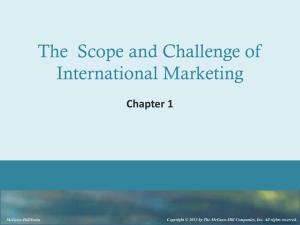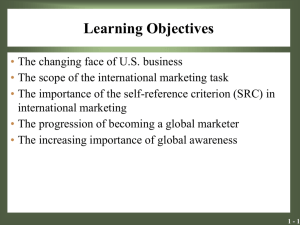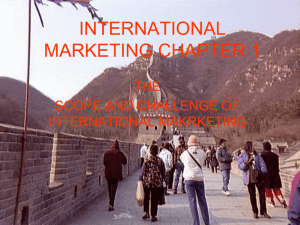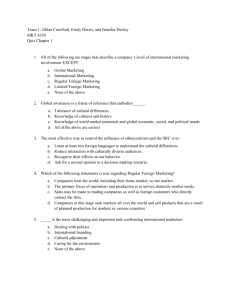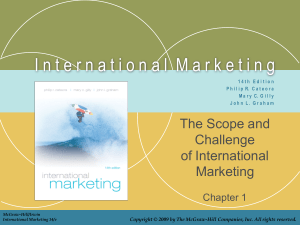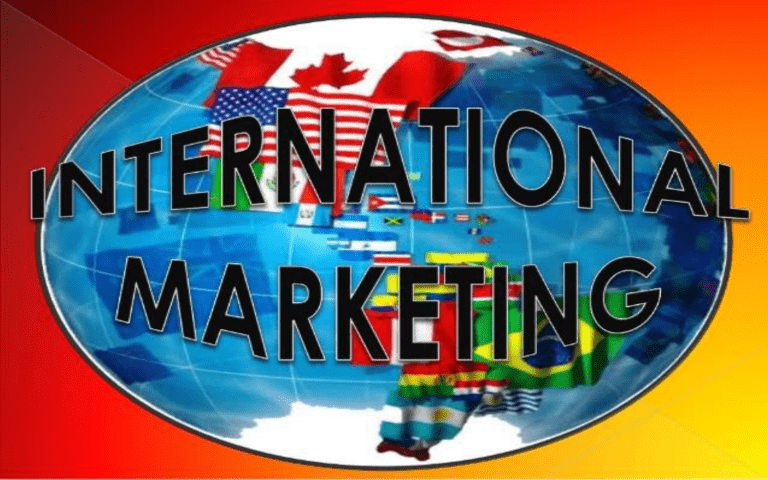
The Scope and Challenge of International Marketing Baluncio – Panuelos MKG802 Major events at the turn of the century: • • • • • • • The technological bubble bust of 2001 Terrorism on 9/11 The Afghanistan and Iraq wars The 2003 SARS outbreak in Asia The Indian ocean Tsunami in December 2004 Price of oil at $100 a barrel NASA budget cuts threaten the demise of the space shuttle program Consumer spending rose despite the layoffs at United Airlines and Boeing and the tough job market • The housing bubble burst during the end of 2008 and the American consumer stopped buying causing a 12 percent drop, the deepest decline in world trade in 50 years! • International trade tensions are rising from competitors in China, Brazil and India • The U.S. trade deficit keeps rising ($14 trillion) • Global Perspective Global Commerce Causes Peace • • • The role of world trade and international marketing in producing peace International marketing promotes peace and prosperity through the marketing of products and services that meet the needs and wants of customers in other lands Two examples Large Multinational – Boeing Small Multinational - PeaceWorks Events and Trends Affecting Global Business • • • • The rapid growth of the World Trade Organization (WTO) and NAFTA and EU The trend toward the acceptance of the free market system among developing countries in Latin America, Asia, and Eastern Europe The burgeoning impact of the Internet, mobile phones, and other global media on the dissolution of national borders The mandate to properly manage the resources and global environment for the generations to come Internationalization of U.S. Business • The world is one market – increasing globalization of markets • Many U.S. companies are foreign controlled 7-Eleven and Firestone – Japan Carnation – Switzerland Wall Street Journal – Australia Smith & Wesson – Britain Zenith – South Korea (LG Electronics) Foreign Acquisitions of U.S. Companies Exhibit 1.1 Internationalization of U.S. Business Foreign companies are here to stay in the U.S. and compete with U. S. companies The great worldwide acquisitions both by U. S. and foreign companies Global markets are a necessity • • • Foreign earnings a higher percentage of profits Multinationals outperform domestic firms Global value increased through global diversification Intensifying domestic competition Selected U.S. Companies and Their International Sales Exhibit 1.2 International Marketing • International marketing is defined as the performance of business activities designed to plan, price, promote, and direct the flow of a company’s goods and services to consumers or users in more than one nations for a profit. International Marketing vs. Domestic Marketing • International Marketing focuses on working in more than one country while Domestic Marketing focuses on working and limited to home country. • International Marketing has more uncontrollable factors while Domestic Marketing has slightly more control factors. The International Marketing Task Marketing Decision • Firm Characteristics • Product • Price • Place • Promotion Domestic Environment • Political / Legal forces • Economic forces • Competition Foreign Environment • • • • • • • Political / Legal Economic forces Competition Level of technology Geography and Infrastructures Cultural Forces Structure of Distribution Environmental Adaptation The most challenging and important adaptation international marketers must make is cultural adjustments. Must establish a frame of reference • • • • • Time-conscious Americans vs. Time-is-not-an-asset thinking Latin Americans Hand gestures vary between countries “Cultural Conditioning” – be aware of home cultural references before making decisions Obstacles to Adaptation Adaptation is a conscious effort on the part of the international marketer to anticipate the influences of both the foreign and domestic uncontrollable factors on a marketing mix and then to adjust the marketing mix to minimize the effects. Two primary obstacles are: • • • • Self-Reference Criterion (SRC) Ethnocentrism Self-Reference Criterion (SRC) Self-Reference Criterion (SRC) is an unconscious reference to one’s own cultural values, experiences, and knowledge as a basis for decision. Risk of SRC: • • Prevent you from becoming aware of cultural differences Influence the evaluation of the appropriateness of a domestically designed marketing mix for a foreign market Ethnocentrism The notion that people in one’s own company, culture, or country know best how to do things. Risk of Ethnocentrism: • • • Impedes the ability to assess a foreign market in its true light Beyond Obstacles to Adaptation The most effective way to control the influence of SRC and Ethnocentrism is: • • • • To recognize the effects on our behavior To recognize that there may be more similarities than differences between countries To conduct crosscultural analysis Cross-Cultural Analysis 1. 2. 3. 4. Define business problem or goal in home-country cultural traits, habits, or norms Define business problem or goal in foreign-country cultural traits, habits, or norms through consultation with natives of target country Isolate the SRC influence and examine it carefully to see how it complicates the problem Redefine the problem without SRC influence and solve for the optimum business goal situation Developing Global Awareness Tolerance of cultural differences • • • You do not have to accept as your own the cultural ways of another, but you must allow others to be different and equal Knowledge of cultures, history, world market potential, and global economic, social, and political trends Approaches to Global Awareness • • • Select individual managers that express a global awareness orientation Develop personal relationships in foreign countries Must have the support of a culturally diverse senior executive staff or board of directors International Marketing Involvement - Stages No Direct Infrequent Foreign Foreign Marketing Marketing Global Marketing Regular Foreign International Marketing Marketing International Marketing Involvement - Stages • No Direct Foreign Marketing (Internet Sales) by using intermediaries, trading companies or middleman. • Infrequent Foreign Marketing surpluses in inventory may cause companies to sell product overseas • Regular Foreign Marketing permanent resources and use intermediaries • International Marketing in this stage has planned production and marketing to many countries • Global Marketing in this stage, the firms start viewing the world as one market Strategic Orientation 1. Domestic market extension orientation 2. Multi-Domestic market orientation 3. Global market orientation
